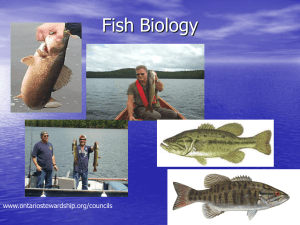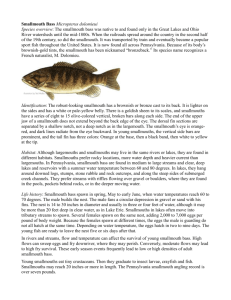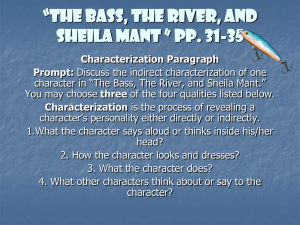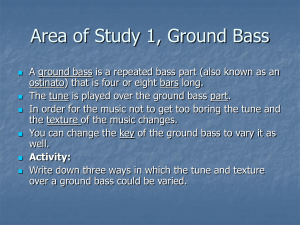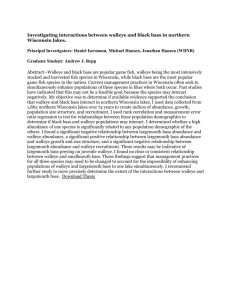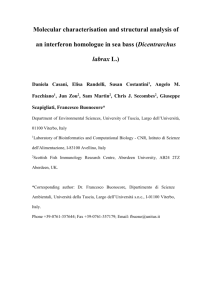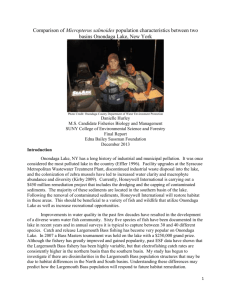Supplementary Information for - Proceedings of the Royal Society B
advertisement
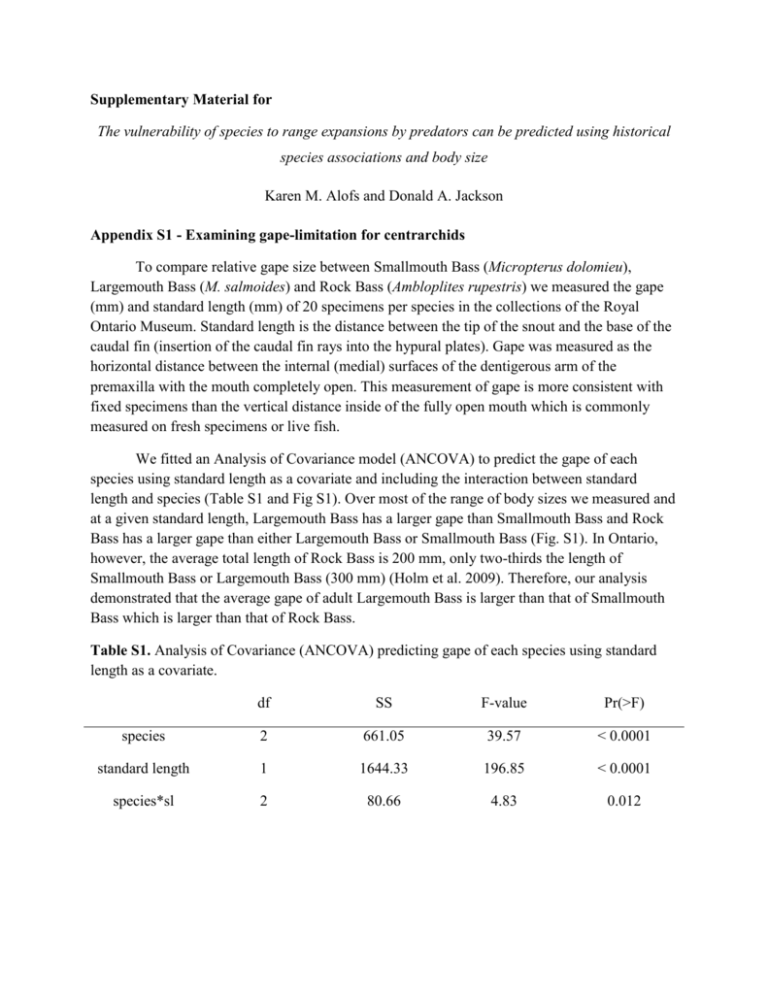
Supplementary Material for The vulnerability of species to range expansions by predators can be predicted using historical species associations and body size Karen M. Alofs and Donald A. Jackson Appendix S1 - Examining gape-limitation for centrarchids To compare relative gape size between Smallmouth Bass (Micropterus dolomieu), Largemouth Bass (M. salmoides) and Rock Bass (Ambloplites rupestris) we measured the gape (mm) and standard length (mm) of 20 specimens per species in the collections of the Royal Ontario Museum. Standard length is the distance between the tip of the snout and the base of the caudal fin (insertion of the caudal fin rays into the hypural plates). Gape was measured as the horizontal distance between the internal (medial) surfaces of the dentigerous arm of the premaxilla with the mouth completely open. This measurement of gape is more consistent with fixed specimens than the vertical distance inside of the fully open mouth which is commonly measured on fresh specimens or live fish. We fitted an Analysis of Covariance model (ANCOVA) to predict the gape of each species using standard length as a covariate and including the interaction between standard length and species (Table S1 and Fig S1). Over most of the range of body sizes we measured and at a given standard length, Largemouth Bass has a larger gape than Smallmouth Bass and Rock Bass has a larger gape than either Largemouth Bass or Smallmouth Bass (Fig. S1). In Ontario, however, the average total length of Rock Bass is 200 mm, only two-thirds the length of Smallmouth Bass or Largemouth Bass (300 mm) (Holm et al. 2009). Therefore, our analysis demonstrated that the average gape of adult Largemouth Bass is larger than that of Smallmouth Bass which is larger than that of Rock Bass. Table S1. Analysis of Covariance (ANCOVA) predicting gape of each species using standard length as a covariate. df SS F-value Pr(>F) species 2 661.05 39.57 < 0.0001 standard length 1 1644.33 196.85 < 0.0001 species*sl 2 80.66 4.83 0.012 Fig. S1. Gape (mm) versus standard length (mm) and relationships fitted in ANCOVA for Smallmouth Bass (squares and dashed line), Largemouth Bass (circles and solid line) and Rock Bass (triangles and dotted line). Appendix S2 – Incorporating environmental variation using multimodel inference To investigate the possibility that the differences in species losses we observed were due to confounding environmental factors rather than centrarchid introductions, we calculated odds ratios (OR) from logistic regression models which estimate the impact of species introductions accounting for environmental variables. The OR is conceptually similar to the relative risk ratio (RR) and can be calculated from contingency tables, however, ORs are known to over-estimate risk when occurrences are not rare and they are often misinterpreted [1–3]. We assembled environmental variables for each lake including: surface area (ha), maximum depth (m), elevation (m), Secchi depth (m), total dissolved solids, average annual growing degree-days above 5 degrees C between 1961 and 1990, and distance to the nearest road. We also included the number of years elapsed between historical and contemporary surveys. Distance to the nearest road was calculated using ArcGIS 10 (Environmental Systems Research Institute Inc., Redlands, CA, USA). Road access is indicative of many anthropogenic factors including development, fishing pressure and fish introductions [4]. Growing degree-days were estimated by thin-plate spline smoothing algorithms and provided by the Canadian Forestry Service (http://cfs.nrcan.gc.ca/projects/3). All other variables were from the Ontario Ministry of Natural Resources Aquatic Habitat Inventory. Model fitting required that we exclude lakes for which any of these measures were missing, leaving 1480 lakes in our analysis. All variables except elevation, growing degree-days and the years between surveys were natural log transformed to meet normality assumptions. For each ‘introduced centrarchid’-‘resident’ species pair, we fitted a series of candidate logistic regression models predicting the loss of the resident species (in lakes where the resident was historically present and the centrarchid was historically absent) with all possible combinations predictors including the above described environmental variables, years between surveys and the presence or absence of the centrarchid species introduction. We excluded species pairs for which there were no lakes with the introduced centrarchid in which the resident species was lost (Largemouth Bass and Northern Pike or Shorthead Redhorse) or survived (Smallmouth Bass and Fathead Minnow or Pearl Dace; Largemouth Bass and Brook Stickleback, Iowa Darter, Lake Chub, Longnose Sucker, or Northern Redbelly Dace; Rock Bass and Fathead Minnow). We also excluded models predicting Largemouth Bass losses with Smallmouth Bass introductions because there were too few lakes with data for this species pair. For each of the remaining 76 species pairs, we applied an information theoretic approach and averaged the top (lowest AIC) candidate models [5]. Model averaging was performed in R with the ‘MuMIn’ package. For each candidate model we calculated Akaike weight (wi) which is the model likelihood normalised by the sum of all model likelihoods. We averaged those models with a cumulative sum of wi = 0.9 (the 90% confidence set of models; [6]). Model averaging calculates parameter estimates by downweighting models that explain little variance in the response. The exponentiated coefficient estimate for centrachid species introduction from the average model is the OR associated with species introductions accounting for environmental covariates. Positive ORs indicate the negative impact of centrarchid introduction on resident species survival. We found that, while OR incorporated the potential effects of confounding environmental factors on resident species losses, OR did not substantially differ from RR. Pearson productmoment correlations between OR and RR where > 0.80 for all three introduced centrarchids (Fig. S2). Moreover, deriving OR from logistic regression was substantially more data and computationally intensive and could be calculated for fewer species combinations. Finally, we fitted multiple linear regression models predicting ln(relative risk ratio) or ln(odds ratio) of centrarchid introduction for resident species with the historical Phi coefficient and ln(total length). We found that historical species associations and body size were comparable predictors of the estimated impact of centrarchid introductions whether the OR or RR measure was used (Table S2). References 1. Davies, H., Crombie, I. & Tavakoli, M. 1998 When can odds ratios mislead? BMJ 316, 989–991. 2. Deeks, J. 1998 When can odds ratios mislead? Odds ratios should be used only in case– control studies and logistic regression analyses. BMJ 317, 1155. 3. Montreuil, B., Bendavid, Y. & Brophy, J. 2005 What is so odd about odds? Can. J. Surg. 48, 400–408. 4. Kaufman, S. D., Snucins, E., Gunn, J. M. & Selinger, W. 2009 Impacts of road access on lake trout (Salvelinus namaycush) populations: regional scale effects of overexploitation and the introduction of Smallmouth Bass (Micropterus dolomieu). Can. J. Fish. Aquat. Sci. 66, 212–223. (doi:10.1139/F08-205) 5. Burnham, K. P. & Anderson, D. R. 2002 Model Selection and Multimodel Inference: A Practical Information-Theoretic Approach. 2nd edn. New York, New York, USA: Springer-Verlag. 6. Johnson, J. B. & Omland, K. S. 2004 Model selection in ecology and evolution. Trends Ecol. Evol. 19, 101–8. (doi:10.1016/j.tree.2003.10.013) Fig. S2. Distribution of ln(odds ratio) versus ln(relative risk ratio) for resident species with the introduction of A) Smallmouth Bass (r = 0.848), B) Largemouth Bass (r = 0.858) and Largemouth Bass (r = 0.816). A) B) C) Table. S2 Multiple regression models predicting the ln(relative risk ratio) or ln(odds ratio) of centrarchid introduction for resident species with the Phi coefficient and ln(total length). estimate (beta) ratio Smallmouth Bass Largemouth Bass intercept Phi ln(total length) df p - value R2 ln(RR) -0.081 -0.313**** -0.154* 23 0.0002 0.516 ln(OR) 0.360** -0.792**** -0.180 23 < 0.0001 0.557 ln(RR) -0.131 -0.535**** 0.009 19 0.0004 0.566 ln(OR) -0.145 -0.874**** 0.142 19 0.0019 0.484 ln(RR) -0.088 -0.263*** -0.166** 25 < 0.0001 0.483 ln(OR) 0.247** -0.693**** -0.240* 25 < 0.0001 0.650 Rock Bass *< 0.10, **< 0.05, ***< 0.01, ****< 0.001

